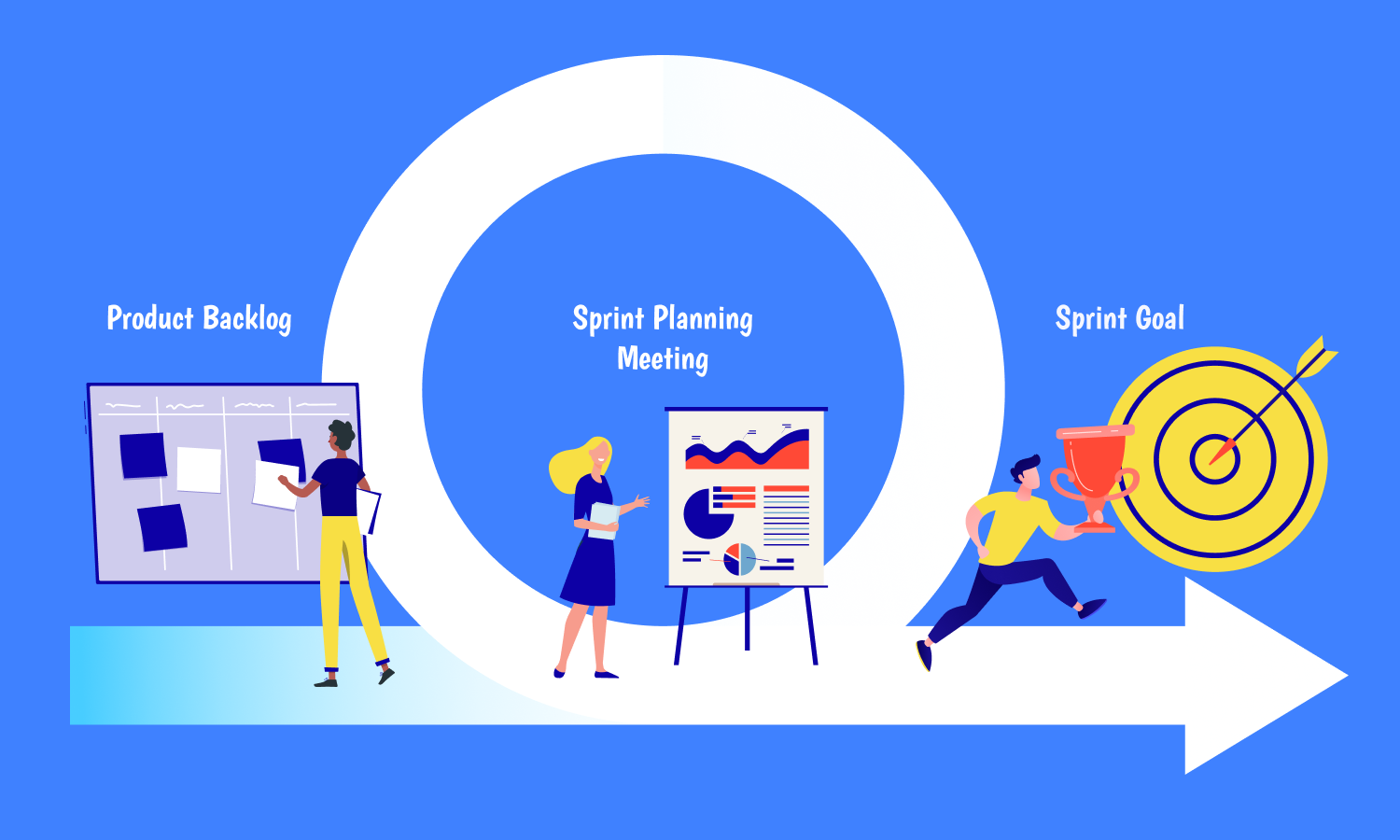The Agile methodology has emerged as a beacon of adaptability and efficiency in the ever-evolving software development landscape.
At the heart of Agile lies sprint planning and review meetings, two pivotal events that drive the rhythm of the development process.
Ideas are transformed into actionable plans and progress is showcased in these meetings.
Yet, orchestrating these symphonies of collaboration and innovation requires a maestro—the Business Analyst (BA).
Let’s delve into the world of Agile sprint planning and review, and uncover the indispensable role that BAs play in orchestrating these dynamic events.

Business Analysts and Their Role
In the dynamic world of Agile methodology, sprint planning, and sprint review meetings are essential milestones that keep the development engine humming.
Business analyst skills play a pivotal role in ensuring the success of these events.

Sprint Planning: The Business Analyst as a Strategic Partner
In the realm of sprint planning, BAs don multiple hats. They collaborate closely with the development team and the Product Owner to ensure that the upcoming sprint is set up for success. Here’s how BAs contribute:
Analyzing Business Needs: BAs dive deep into understanding the business’s requirements, translating them into user stories that developers can grasp easily. This translation is vital for ensuring that technical tasks align with business objectives.
Refining the Backlog: The sprint backlog, a collection of user stories and tasks, needs to be well-defined. BAs refine and clarify backlog items, ensuring they are ready for development.
Estimating Story Points and Team Capacity: BAs employ their analytical skills to estimate the effort required for each user story. They consider the team’s capacity and ensure that the sprint goal is achievable within the set timeframe.
Realistic Sprint Goals: BAs act as a buffer against unrealistic expectations. They collaborate with stakeholders to ensure that the sprint goal is not only ambitious but grounded in practicality.
Sprint Review: The Business Analyst as a Storyteller
As the sprint concludes, the spotlight shifts to the review meeting, where business analysts once again shine:

Presenting User Stories: Business analysts take center stage by presenting user stories to stakeholders. They explain the technical implementation behind each story and how it contributes to the overall business process.
Addressing Stakeholder Queries: Stakeholders often have questions or suggestions during the review. BAs serve as the point of contact, addressing queries and providing insights into the development process.
Collaborating for Improvement: Business analysts collaborate with the Scrum Master, development team, and stakeholders to discuss achievements and challenges. Their ability to bridge the gap between technical and business perspectives is invaluable in these discussions.
Sharing the Big Picture: Business analysts offer a holistic view of the sprint’s outcomes, showcasing the value delivered to the business. They ensure that stakeholders grasp not only the technical achievements but also the broader implications.
In essence, Business analysts are the conductors of this Agile symphony.
They harmonize technical intricacies with business goals, ensuring that every note played contributes to a masterpiece of efficiency and value. As the Agile journey continues, the Business Analyst’s role remains essential in guiding the team toward success, sprint after sprint.
IT business analyst
An IT business analyst specializes in technology-related projects. In sprint planning and review meetings, they bring a deep understanding of technical considerations to ensure that user stories are not only aligned with business needs but also technically feasible.
Understanding Agile Sprint Planning
Imagine you’re planning a road trip with your friends. You’ve got a map, a car, and a destination in mind. Agile sprint planning is a bit like that but for software development teams.
In the world of making apps, websites, and other cool digital stuff, Agile is a way of working that’s all about being flexible and efficient. A “sprint” is like a short, focused burst of work, usually around two weeks long.
Sprint planning is when the team gets together to figure out what they’ll do in that sprint.

Sprint Planning Session: Setting the Stage
A sprint planning session is the spark that ignites the sprint’s fire. It’s a collaborative gathering where the entire Agile team assembles to outline the sprint’s direction. Developers, business analysts, and product owners join forces to dissect the sprint backlog, paving the way for the sprint’s execution.
Sprint Planning Meeting: Confluence of Minds
The sprint planning meeting is where the magic truly unfolds. Business analysts bring their business acumen to the table, aligning the team’s technical prowess with overarching business objectives. This confluence of minds lays the groundwork for a successful sprint, fusing strategic vision with actionable tasks.

Unveiling the Sprint Backlog: A Treasure Trove
Central to sprint planning is the sprint backlog—a treasure trove of user stories and development tasks.
Business analysts, with their keen analytical skills, dive into this backlog. They decode intricate business processes, translating them into user stories that developers can seamlessly transform into code.
Stages of Agile planning
The three stages of Agile planning are:
Release Planning: In this initial stage, the team sets the overall vision and goals for the project or product. High-level features and priorities are defined, and a rough timeline for releases is established. The focus is on aligning the project with business objectives and creating a roadmap for development.
Iteration Planning: Also known as sprint planning, this stage occurs before each sprint. The team selects user stories or backlog items from the product backlog, breaks them down into actionable tasks, estimates effort, and commits to completing the work within the sprint’s timeframe. Iteration planning ensures a clear focus for the upcoming sprint and helps manage workload and expectations.
Daily Planning (Daily Standup): While not a formal planning stage, daily standup meetings are essential for coordinating daily tasks within the team. During these brief meetings, team members discuss their progress, challenges, and planned activities. This helps identify and address any obstacles promptly, ensuring the team remains on track toward achieving sprint goals.
These three stages collectively provide a structured approach to managing Agile projects, aligning development efforts with business goals, and maintaining continuous communication and adaptation throughout the project’s lifecycle.
The Dance of Collaboration
Here, business analysts step onto the stage, twirling in a dance of collaboration. They fuse their business acumen with the technical prowess of the development team. Together, they dissect the sprint backlog, a treasure trove of scenarios and backlog items. Business analysts unravel intricate business processes, decoding them into detailed narratives that the development team can seamlessly translate into code.
Estimating the Journey
The spotlight then shifts to estimating—story points take center stage. Business analysts, with their analytical skills honed, aid in estimating the effort required for each story. They consider the team’s capacity and ensure that the sprint goal isn’t an elusive mirage. This is where their knack for managing stakeholders’ expectations shines. Unrealistic expectations are turned into grounded, achievable sprint goals.
The BA’s Role in Sprint Review Meetings
As the sprint reaches its end, the excitement builds for the sprint review meeting – the highlight of the Agile rhythm. This is when the results of the team’s hard work come to life, like a curtain lifting on a stage performance.
Picture a painter unveiling their masterpiece; similarly, completed tasks and projects take center stage. Business analysts step in as storytellers, guiding us through the journey of each task. They connect the dots, showing how each bit of code fits into the bigger picture of the business.
Think of them as translators, making the technical details relatable to the business goals. Just like in a good story, they help us see how each piece contributes to the grand storyline of the company’s success. Through their insights, we understand how the sprint’s efforts propel the business forward, turning development work into real-world impact.

Weaving Stakeholder Feedback
Stakeholders enter the scene, applauding or offering their insights from the culmination of the previous sprint. Business analysts, positioned at the crossroads of technology and business, deftly channel these valuable insights back to the development group. They take these learnings and seamlessly weave them into the evolving symphony of the Agile process.
This symphony, orchestrated by their expertise, ensures that the next sprint harmonizes even better with the intricate needs and aspirations of the business. Through this continuous refinement, business analysts contribute to an Agile cadence that resonates more powerfully with every iteration.
Maximizing the BA’s Impact
A key characteristic of BAs is their ability to bridge gaps, to transform technical symphonies into melodies understood by all. Their collaborative spirit blends seamlessly with Agile teams.
BAs juggle roles—translator, diplomat, and innovator. They sew shared understanding across team members, harmonizing technicalities with the big picture of business goals.
Pioneering the Big Picture
BAs don’t merely manage backlogs; they envision the grand narrative. Aligning sprint aims with overarching business objectives, BAs don the hat of strategists. As the team weaves through sprints, BAs ensure the trajectory steers towards the horizon of business success.
Ensuring Flawless Execution
Behind the scenes, a meticulous endeavor unfolds—the sprint backlog’s evolution. BAs remain the custodians, ensuring the backlog items are up to date. This isn’t just a chore; it’s a symphony of precision.
By refining and completing backlog items, BAs keep the development engine humming.
Collaborating for Continuous Improvement
In the retrospective, BAs wield their analytical sword once again. Collaborating with the Scrum Master and the development group, they dissect the sprint’s performance. Like archaeologists of agility, BAs unearth areas of enhancement. Their insights feed into the Agile machinery, shaping future sprints.
Conclusion
As the curtain falls on this Agile spectacle, one thing becomes clear—Business Analysts are the unsung heroes of sprint planning and review meetings.
They blend the colors of business and technology, weaving a tapestry of collaboration, innovation, and value.
From deciphering business needs to choreograph the sprint’s journey, BAs breathe life into Agile’s heartbeat.
So, the next time you witness the dance of Agile, remember the Business Analyst—the architect behind the scenes, crafting Agile’s symphony of success.

People Also Ask (FAQs)
What exactly is the role of a Business Analyst (BA) in Agile sprint planning and review meetings?
BAs play a multifaceted role in sprint planning and review meetings. In sprint planning, they collaborate with the development team and Product Owner to analyze business needs, refine backlog items, estimate story points, and ensure realistic sprint aims. During sprint reviews, BAs act as storytellers, presenting user stories, addressing stakeholder queries, collaborating with the team, and offering a holistic view of the sprint’s outcomes.
What is a sprint planning meeting?
A sprint planning meeting is a crucial event in Agile methodology where the development team gathers to plan the upcoming sprint. It involves selecting backlog items, breaking them into tasks, estimating effort, and setting a sprint goal.
How does business analysis contribute to sprint planning meetings?
Business analysis plays a vital role by leveraging its insights into business processes. Business analysts collaborate with the team to refine backlog items, ensure user stories align with business needs, and assist in prioritization for a successful sprint.
Can you explain the business analysis process within sprint planning meetings?
The business analysis process involves gathering requirements, refining user stories, translating business requirements into actionable tasks, and facilitating collaboration between technical and non-technical team members during sprint planning meetings.



